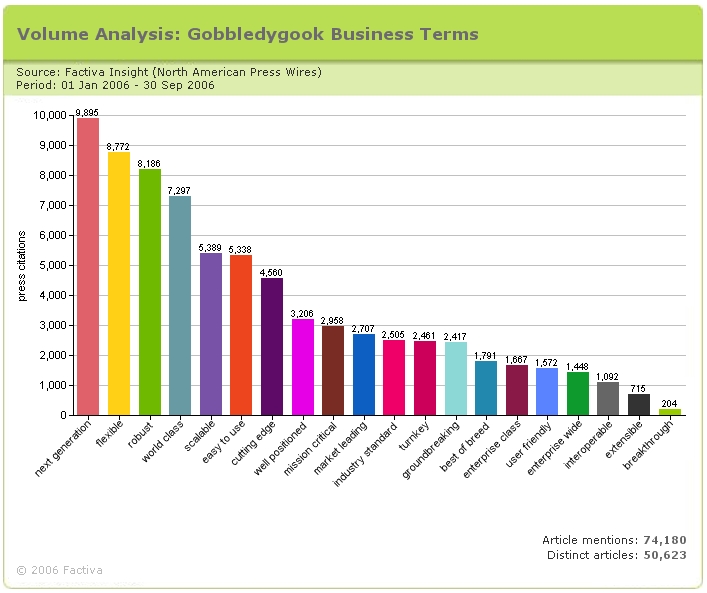Oh jeez, not another flexible, scalable, groundbreaking, industry-standard, cutting-edge product from a market-leading, well positioned company! Ugh. I think I'm gonna puke!
Just as teenagers use catch phrases, certain words and phrases crop up again and again in Web sites and news releases—so much so that the gobbledygook grates against my nerves and many other people's, too.
Well, duh. Like, companies, yeah, they just totally don't communicate very well, you know?
As a journalist, I get a hundred or so news releases each week and look at dozens of Web sites a day. Sadly, nearly all are laden with meaningless gobbledygook. I wanted to analyze how many of these words are being used, and so I created a method to do so.
An Analysis of Gobbledygook
First, by polling select PR people and journalists and asking them to write a list of gobbledygook phrases, I selected those that are overused in news releases. Then I turned to Factiva, a Dow Jones and Reuters Company, for help with my analysis.
The folks at the Factiva Reputation Lab used text-mining tools to analyze news releases sent by companies in North America from January 1 to September 30, 2006. Factiva analyzed each release in its database, which consists of releases sent to one of the North American news release wires it distributes, including Business Wire, Canada NewsWire, CCNMatthews, Commweb.com, Market Wire, Moody's, PR Newswire, and Primezone Media Network.
The results were staggering. The news release wires collectively distributed just over 388,000 news releases in the nine-month period, and just over 74,000 of them used at least one of the Gobbledygook phrases.
The winner was "next generation," with 9,895 uses, and there were over 5,000 uses of each of the following words and phrases: "flexible," "robust," "world class," "scalable," and "easy to use."
Other notably overused phrases with between 2,000 and 5,000 uses included "cutting edge," "mission critical," "market leading," "industry standard," "turnkey," and "groundbreaking." And let's not forget "interoperable," "best of breed," and "user friendly," each with over 1,000 uses in news releases.
How Did We Get Here?
People often say to me, "Everyone in my industry writes this way. Why?"
Here's how the usual dysfunctional process works and why these phrases are so overused: Marketers don't understand buyers, the problems buyers face, or how their product helps solve these problems. That's where the gobbledygook happens.
First, the marketing person bugs the product managers and others in the organization to provide a set of the product's features. Then the marketing person reverse-engineers the language that they think the buyer wants to hear based not on buyer input but on what the product does. A favorite trick that some ineffective marketers use is to take the language that the product manager provides, go into Microsoft Word's find-and-replace mode, substitute the word "solution" for "product," and then slather the whole thing with superlative-laden, jargon-sprinkled hype.
By just decreeing, through an electronic word substitution, that "our product" is "your solution," these companies effectively deprive themselves of the opportunity to convince people that this is the case.
I'll admit that the gobbledygook phrases I chose are mainly used by technology companies operating in the business-to-business space. If you are writing for a company that sells different kinds of products (shoes, perhaps), then you would probably not be tempted to use many of the above phrases. The same thing is true for nonprofits, churches, rock bands, and other organizations—they're also unlikely to use these sorts of phrases. But the lessons are the same. Avoid the insular jargon of your company and your industry. Instead, write for your buyers.
"Hold on," you might say. "The technology industry may be dysfunctional, but I don't write that way."
The fact is that similar nonsense goes on in all industries. Here's an example from the world of local government: "The sustainability group has convened a task force to study the cause of energy inefficiency and to develop a plan to encourage local businesses to apply renewable-energy and energy-efficient technologies which will go a long way toward encouraging community buy-in to potential behavioral changes." What the heck is that?
Write for Your Buyers
Your buyers (and the media that cover your company) want to know what specific problems your product solves, and they want proof that it works—in plain language.
Your marketing and PR are meant to be the beginning of a relationship with buyers and to drive action (such as generating sales leads), which requires a focus on buyer problems. Your buyers want to hear this in their own words.
Every time you write—yes, even in news releases—you have an opportunity to communicate. At each stage of the sales process, well-written materials will help your buyers understand how you, specifically, will help them.
Your marketing and PR are meant to be the beginning of a relationship with buyers (and journalists). This begins when you work at understanding your target audience and figure out how they should be sliced into distinct buying segments or buyer personas. Once this exercise is complete, identify the situations each target audience may find themselves in.
What are their problems? Business issues? Needs? Only then are you ready to communicate your expertise to the market.
Here's the rule: When you write, start with your buyers, not with your product.





